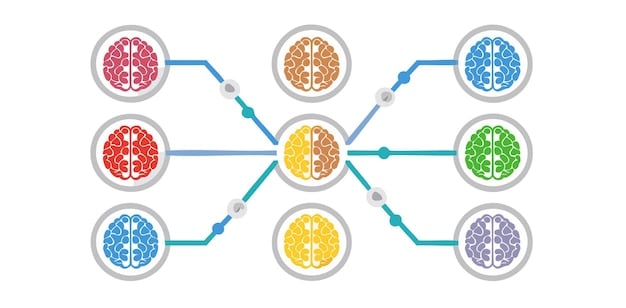Diet and ADHD in Children: A Comprehensive Guide

Understanding the link between diet and ADHD in children involves examining how certain foods and nutrients can influence symptoms, prompting discussions on dietary interventions like elimination diets and supplementation.
Navigating the challenges of ADHD in children can be overwhelming, and understanding the link between diet and ADHD in children: a comprehensive guide offers a beacon of hope for parents seeking strategies to support their child’s well-being.
The Basics of ADHD and its Impact on Children
Attention-Deficit/Hyperactivity Disorder (ADHD) is a neurodevelopmental condition affecting millions of children worldwide. It’s crucial to understand the core symptoms and how they can manifest differently in each child.
Understanding ADHD Symptoms
ADHD is characterized by a persistent pattern of inattention, hyperactivity, and impulsivity. These symptoms can significantly impact a child’s academic performance, social interactions, and overall quality of life.
Inattention can manifest as difficulty sustaining focus, being easily distracted, forgetfulness, and struggling to follow instructions. Hyperactivity can present as excessive fidgeting, difficulty staying seated, and constant movement. Impulsivity involves acting without thinking, interrupting others, and difficulty waiting their turn.
The Impact of ADHD on Daily Life
The challenges of living with ADHD can extend beyond the classroom. Children with ADHD may struggle with forming and maintaining friendships, managing emotions, and completing everyday tasks.
- Academic Difficulties: Challenges in focusing and completing assignments can lead to poor grades and frustration in school.
- Social Challenges: Impulsivity and difficulty understanding social cues can lead to misunderstandings and conflicts with peers.
- Emotional Regulation: ADHD can affect emotional regulation, leading to increased irritability, mood swings, and difficulty managing frustration.
Recognizing these impacts is the first step in seeking appropriate interventions and support for children with ADHD.
In conclusion, understanding the multifaceted nature of ADHD is vital for providing tailored support. Recognizing the distinct symptoms and their pervasive impact sets the stage for targeted interventions, including dietary considerations, to improve the well-being of children with ADHD.
The Gut-Brain Connection: An Overview
The gut-brain connection is a growing field of research exploring the complex relationship between the digestive system and the brain. Understanding this connection is crucial when considering the impact of diet on ADHD.

How the Gut Microbiome Affects Brain Function
The gut microbiome, the community of microorganisms living in the digestive tract, plays a significant role in influencing brain function. These microorganisms produce neurotransmitters, regulate inflammation, and affect the production of essential vitamins.
An imbalance in the gut microbiome, known as dysbiosis, has been linked to various neurological and psychiatric conditions, including ADHD. Dysbiosis can lead to increased inflammation and disruptions in neurotransmitter production, potentially exacerbating ADHD symptoms.
The Role of Inflammation in ADHD
Chronic inflammation has been identified as a potential contributing factor to ADHD. Inflammatory markers have been found to be elevated in some individuals with ADHD, suggesting a link between inflammation and the disorder.
- Dietary Triggers: Certain foods, such as processed foods, refined sugars, and artificial additives, can promote inflammation in the gut.
- Gut Permeability: A compromised gut barrier can allow inflammatory substances to enter the bloodstream, triggering a systemic inflammatory response.
- Neuroinflammation: Inflammation in the brain can disrupt neuronal function and contribute to ADHD symptoms.
Addressing inflammation through dietary modifications may help alleviate some ADHD symptoms by promoting a healthier gut environment and reducing systemic inflammation.
In summary, exploring the gut-brain connection provides a deeper understanding of how diet can influence ADHD in children. By focusing on maintaining a balanced gut microbiome and reducing inflammation, it’s possible to positively impact brain function and manage ADHD symptoms more effectively.
Key Nutrients for Brain Health and ADHD Management
Specific nutrients play vital roles in brain health and function, making them particularly important for managing ADHD symptoms. Ensuring children receive adequate amounts of these nutrients can support optimal brain function.
Omega-3 Fatty Acids
Omega-3 fatty acids, especially EPA and DHA, are essential for brain development and function. They have been shown to improve attention, reduce hyperactivity, and enhance cognitive performance in children with ADHD.
Excellent sources of omega-3 fatty acids include fatty fish (such as salmon, mackerel, and sardines), flaxseeds, chia seeds, and walnuts. Supplementation with omega-3 fatty acids can also be considered under the guidance of a healthcare professional.
Iron
Iron deficiency is common in children with ADHD, and studies have shown a correlation between low iron levels and increased ADHD symptoms. Iron is crucial for the production of neurotransmitters like dopamine, which is involved in attention and motivation.

Zinc
Zinc is another essential mineral that plays a role in neurotransmitter function and brain development. Research suggests that zinc supplementation may help improve attention and reduce hyperactivity in some children with ADHD.
- Food Sources: Include zinc-rich foods such as oysters, beef, pumpkin seeds, and cashews in your child’s diet.
- Supplementation: Zinc supplements are available, but it is crucial to consult with a healthcare professional to determine the appropriate dosage.
In conclusion, these key nutrients are essential for supporting brain health and managing ADHD symptoms. However, you should consult with a healthcare provider or nutritional expert for tailored guidance.
Foods to Limit or Avoid: The Impact of Sugar, Additives, and Allergens
Certain foods and additives can negatively impact ADHD symptoms in some children. Limiting or avoiding these substances may help improve focus, reduce hyperactivity, and manage overall behavior.
The Role of Sugar in Exacerbating ADHD Symptoms
Excessive sugar consumption can lead to rapid spikes and crashes in blood sugar levels, which can affect mood, energy, and cognitive function. High sugar intake has been linked to increased hyperactivity and impulsivity in children with ADHD.
Limit or avoid sugary drinks, candies, and processed snacks. Opt for whole fruits and natural sweeteners in moderation. Be careful of hidden sugars in packaged foods, and always check nutrition labels.
Artificial Additives and Their Potential Effects
Artificial food dyes, preservatives, and flavor enhancers have been implicated in exacerbating ADHD symptoms in some children. These additives may disrupt neurological function and trigger adverse reactions.
- Common Offenders: Be mindful of artificial colors like Yellow 5, Red 40, and Blue 1, as well as preservatives like sodium benzoate.
- Read Labels: Always check ingredient lists carefully and choose products that are free from artificial additives.
Identifying Potential Food Allergens
Food allergies and sensitivities can contribute to inflammation and affect brain function in some children with ADHD. Common allergens include dairy, gluten, soy, and nuts. Identifying and eliminating these allergens may help alleviate some ADHD symptoms.
Consider consulting with a healthcare professional or allergist to conduct allergy testing if you suspect food sensitivities. Keep a food journal to track your child’s diet and any associated symptoms.
In summary, dietary modifications can play a significant role in managing ADHD symptoms. Reducing or eliminating certain foods and additives helps reduce hyperactivity and other associated challenges.
Implementing an Elimination Diet: A Step-by-Step Guide
An elimination diet involves removing certain foods from your child’s diet and gradually reintroducing them to identify potential triggers for ADHD symptoms. This process should be done under the guidance of a healthcare professional.
Consulting with a Healthcare Professional
It is crucial to consult with a pediatrician, registered dietitian, or other healthcare provider before starting an elimination diet. They can evaluate your child’s nutritional needs, monitor their health, and provide guidance throughout the process.
Your doctor can help you identify potential nutrient deficiencies, ensure adequate nutritional intake, and address any underlying health concerns.
The Initial Elimination Phase
During the initial elimination phase, you will remove suspected trigger foods from your child’s diet for a period of 2-3 weeks. Common foods to eliminate include dairy, gluten, soy, sugar, artificial additives, and processed foods.
- Planning Meals: Prepare and plan meals around whole, unprocessed foods such as fruits, vegetables, lean proteins, and whole grains (if gluten is not eliminated).
- Reading Labels: Always read ingredient lists carefully to ensure you are avoiding eliminated foods and additives.
The Reintroduction Phase
After the elimination phase, gradually reintroduce one food at a time, every 2-3 days. Monitor your child for any adverse reactions or symptom exacerbations.
Keep a detailed food journal to record which foods are being reintroduced and any associated symptoms. Common symptoms to watch for include changes in behavior, mood, sleep, digestion, or skin.
To conclude, an elimination diet is a possible solution, however it must be closely monitored and implemented with a healthcare professional.
Practical Dietary Strategies for Managing ADHD
Implementing practical dietary strategies can make a significant difference in managing ADHD symptoms in children. These strategies focus on creating balanced meals, establishing consistent eating habits, and involving children in meal preparation.
Creating Balanced, Nutrient-Rich Meals
Focus on providing meals that are rich in essential nutrients, including omega-3 fatty acids, iron, zinc, and B vitamins. Include plenty of fruits, vegetables, lean proteins, and whole grains in your child’s diet.
Balance each meal with a combination of protein, complex carbohydrates, and healthy fats. This helps stabilize blood sugar and provides sustained energy throughout the day.
Establishing Consistent Eating Habits
Establish a regular meal schedule with consistent meal and snack times. This helps regulate blood sugar levels and provides a predictable routine that can benefit children with ADHD.
- Avoid Skipping Meals: Ensure your child eats breakfast, lunch, and dinner every day.
- Plan Healthy Snacks: Offer healthy snacks between meals, such as fruits, vegetables, nuts, or yogurt.
Involving Children in Meal Preparation
Involve your child in meal planning, grocery shopping, and meal preparation. This can help them become more aware of what they are eating and develop healthier eating habits.
Give your child age-appropriate tasks, such as washing vegetables, measuring ingredients, or setting the table.
In conclusion, dietary strategies can transform the overall wellbeing of any child. By focusing on essential nutrients and establishing routines, families can nurture healthy development.
| Key Point | Brief Description |
|---|---|
| 🧠 Gut-Brain Connection | The gut microbiome can influence brain function and ADHD symptoms. |
| 🐟 Omega-3 Fatty Acids | Essential for brain health, improving attention and reducing hyperactivity. |
| 🚫 Limit Sugar & Additives | Reduce sugar and artificial additives to minimize ADHD symptoms. |
| 🧪 Elimination Diet | Identify food triggers by eliminating and reintroducing foods under supervision. |
Frequently Asked Questions (FAQ)
▼
Yes, diet can play a significant role. Certain foods can exacerbate symptoms, while others may alleviate them through essential nutrients.
▼
Limit sugary drinks, processed snacks, and foods with artificial additives. These can worsen hyperactivity and impulsivity.
▼
Omega-3 fatty acids, iron, and zinc are important for brain health and may help improve ADHD symptoms. Include these in your child’s diet.
▼
An elimination diet involves removing and reintroducing foods to identify triggers. Consult with a healthcare professional before starting one for your child.
▼
Involve your child in meal planning and preparation. This helps them become more aware and engaged in making healthy decisions.
Conclusion
Understanding the intricate link between diet and ADHD in children provides parents and caregivers with valuable insights into managing symptoms through nutrition. By focusing on balanced meals, limiting certain foods, and ensuring adequate nutrient intake, you can significantly support your child’s brain health and overall well-being. Always consult with healthcare professionals to tailor dietary strategies to your child’s specific needs, ensuring a comprehensive and effective approach to managing ADHD.





